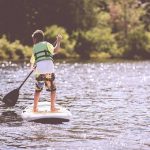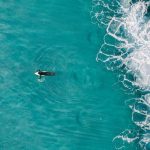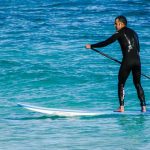Looking to enhance your stand-up paddle board experience?
Look no further than the right accessories. From safety gear to convenience items, we’ve compiled a list of essential accessories you can’t be without.
Read on to discover how these items can take your paddling game to the next level.
And if you’re looking to optimize your SUP experience, our guide will help you choose the right gear that fits your needs and budget.
Must have stand up paddle board accessories
These are the best paddle board accessories. You should bring these items along with you every time you go on the river, or else you are restraining yourself from having a successful experience.
Paddle, fin and manual pump (accessories that come with inflatable paddle boards)
If you’re buying a newly inflatable paddle board, these three items will always be included. You can’t function without them. If you’re getting a second-hand paddle board and it doesn’t include the necessary items, request a lower price since you will have to purchase those extras independently.
Your paddle board may have fins attached to it permanently on the sides, yet you still require a central fin for it. If you’re out in the water for a typical day, you’ll need the primary fin even if you’re in superficial water.
Basics
Keen on appreciating nature and having a good workout? Give paddle boarding a go! It can be accomplished in multiple places, such as tranquil lakes and ponds as well as turbulent ocean waters.
To paddle board in a secure and proficient manner, certain essential gear is necessary. This includes a paddle, a leash, and a pump. Let us examine each item of equipment in more detail.
It’s critical for a stand-up paddle board enthusiast to have the right paddle, and those just starting out should be aware of the different styles and characteristics available and how they will influence their journey.
The two characteristics that are most commonly examined are cost and fabric. It is important to consider the different options and features of these paddles to be able to determine which one is worth the investment.
Aluminum paddles are much cheaper than carbon paddles. You can purchase an aluminium paddle for between £20-£30, and a carbon paddle of good quality will cost around £100-£150 (or higher).
The type of material used has a major influence on the amount of money charged. Carbon paddles are stronger, lighter, and look better. Aluminum is more affordable, however it does weigh more, which can make a significant difference on extended trips.
A paddle is a critical piece of equipment for paddle boarding, so we put together a thorough article about finding the best SUP paddle for any skill level. Have a look at what we suggest for beginners, experts, and those in between.
KERCO Carbon Fiber SUP Paddle (Green)
- Kerco Adjustable Carbon Fiber Stand Up Paddle adjusts…
- Innovative LEVERLOCK handle makes it really easy to…
- 100% Carbon Fiber shaft and fiberglass reinforced nylon…
- Shaft Construction:100% Carbon Fiber .Blade…
A leash is an important piece of safety equipment. It keeps your surfboard attached to your foot and stops it from moving away if you slip off.
More than anything, the type of leash is the most important factor when making a purchase.
There are two kinds of leashes available: coiled and standard. Leashes that are wound in a spiral fashion do not extend to their maximum length unless you end up in the water. The huge perk of this is you won’t be stuck in one place while rowing.
In our article, we provide more in-depth information about leashes.
Check out the best paddle boarding leashes.
A pump is a critical item of SUP gear, as you must fill up your board with air prior to entering the ocean.
There are two types of pumps: manual and electric.
Manual pumps are just that – manual. You must use your own strength to finish the task. Manual pumps are less expensive than those powered by electricity, however they do take more time to inflate a surfboard.
When it comes to hand-operated pumps, those with double- and triple-action capabilities have been seen to be the most effective. You can use these to fill up your inflatable board with air when you are pushing and pulling it.
Electric pumps are introduced further below. If you would like to find out additional information regarding the various pumps, take a look at our post on the top pumps for inflatable paddle boards.
Safety First
It is essential that you take the necessary steps to protect yourself in case of an emergency. Be sure to have a plan in place for potential emergencies so you can stay safe.
Besides a leash, having a life jacket or other flotation device is especially essential – even for your beloved pet. Make sure that everyone you are paddling with is wearing a life jacket.
It is essential that you know how to administer first aid in the event of an emergency. Make sure to always have a phone near you that you can use to request help.
It is essential that even proficient swimmers always have a life preserver on hand! No matter your level of expertise, mishaps can always occur.
One of the key distinctions between multiple types of life preservers is that certain life preservers will keep your head out of the water, whereas others will merely keep you afloat.
The most important factor to consider when paddle boarding is having the ability to move freely. Additionally, a vest should not have any dangling strings or material that can wrap around you. Search for a design with adjustable straps and many compartments.
We have assembled additional valuable data regarding life jackets in another article.
PFD
If you feel that a life jacket is overly cumbersome, you can also utilize a Personal Flotation Device (PFD) instead. Personal flotation devices aren’t as buoyant as a life jacket, yet they still accomplish the task in many circumstances and can be less cumbersome.
Buoys that float can be activated by a carbon dioxide cartridge that sets off a trigger when dropped into the water, or by being inflated automatically.
This model is both minuscule and feathery in weight, however, comes at a hefty cost. Typically, they come with a few cartridges that you can use to fill them up again.
A benefit of PFDs is that they allow for more movement than a life jacket does.
Onyx Unisex Belt Pack Manual Inflatable Life Jacket (PFD)
- U.S. Coast Guard Approved Inflatable Belt Pack – Manual…
- 16 gram CO2 charge provides 17 lbs. of buoyancy
- The oral inflation tube can be used by wearer to…
- Secure Pull – clips to life jacket; allows for quick…
Swimline Foam Ring Pool Buoy
- Foam Ring Buoy
- Easy to store to make safety a priority for your pool
- 18″ Diameter
- Nylon Tow Rope Surround
Ensure that your pooch has a life vest on if they accompany you on your paddleboard. There are particular life vests designed for dogs that ensure their safety when in or around the water.
This also goes for dogs: even if they are great swimmers, they should still wear a flotation device.
The key factor is that the vest fits properly. The product has an added advantage of having a handle to carry it, a loop for attaching a leash, and reflective parts to enhance visibility.
Vests are available with added features such as a shark fin on the back. Check out the best life vests for dogs.
SUP leash
A SUP leash is another item that is usually sold with a paddle board. A SUP leash has a strap with Velcro closures that encircles the ankle on one side, and is connected to a specific point on the board on the other side. It prevents you from being separated from your board if you ever lose your balance.
You’ll want to attach a leash to your board in most circumstances, particularly when you’re going surfing. They’re highly practical. It is not appropriate to use a leash in certain circumstances.
If you are kayaking or canoeing on a river, it’s best to leave the cord attached to the paddle at home unless your safety vest can easily be detached.
There is a potential hazard of being ensnared when out on a river, as the current can make it hard to untangle the rope that is secured around the ankle;
It could be a rock, log or other object that is preventing you from separating the clasp and could leave you submerged.
If you usually explore the ocean, lake, or reservoir by paddling, you should wear a leash connected to your board so that you don’t drift apart and wear yourself out trying to retrieve it.
Life jacket
It is recommended that you wear a PFD when kayaking or canoeing even if you have strong swimming skills. They have the potential to keep you alive, and in some situations, it is legally mandated.
If you don’t appreciate the comfort of a traditional personal flotation device, you should think about purchasing one that goes around your midsection and can be inflated by tugging on a cord.
Kayak seat
Kayaks require seats for those just starting out, as well as for experienced paddlers who will be traveling for extended periods. These allow you to sit down comfortably while paddling.
If you’re interested in paddling over a long distance, it is advisable to sit down after two or three miles have been covered, as this activity can be quite tiring.
These operate by connecting to the D shaped rings on your stand-up paddleboard.
Price tags at some shops have these inflatables at $90, and all Glide models accompanying a complimentary kayak seat, with the exception of the whitewater board which is made up of minimal solid sections to hinder you from injuring yourself while paddling rapids.
SUP board bags
Board bags are ideal for keeping your inflatable paddle board secure, as well as getting it from one location to another. Search for a surfboard which has a packable bag with wheels and straps so it’s simple to take it down to the beach. You can quickly access your board and whatever gear you need for a fishing expedition or just a relaxed paddle on a pleasant summer day with your board bag.
Great SUP accessory for many paddlers but not a necessity
I really love these particular paddle board accessories, however I could do without them if I was in a bind. The majority of these items will not be included when you purchase a paddle board, however you can locate them at an affordable cost over the internet.
Electric pump and battery
Having an electric pump can be beneficial for those who own an inflatable board, but it is not an absolute requirement. If you don’t object to pumping your boards manually each time you use it, or don’t want to spend money to buy one, then you could still make do without one.
Electric pumps are really useful, yet if you tire yourself out trying to inflate your paddleboard or if you are trying to be efficient with your time.
Approximately 10 minutes is enough for an electric pump to blow up a paddle board, but it can take somewhere between 15-30 minutes for someone using a hand pump to finish the job, depending on the size of the board and their personal level of stamina.
You can leave your board and do other things, like applying sunscreen for a sun-blocking or putting your paddle attire on.
You can get an electric pump which connects to the 12v port of your car. You may also acquire a battery pack complete with a 12v outlet so you have the capability to use the pump in other locations.
In conclusion, if you have the financial ability, I suggest investing in an electric pump.
Anchor pole or anchor kit
It can be a plus to have something on your paddle board to keep you steady. It’s a lot simpler to go fishing, have a conversation or a meal with pals, or even jump in the lake for a dip.
An anchor kit usually consists of a piece of rope that is connected to the handle or one of the D-rings of your stand up paddle board and a metal weight on the other end that sinks to the bottom when dropped into the water.
The length of the rope you attach will depend on the depth of the water you’re in, and the longer the rope, the farther you’ll be able to drift from your anchoring point.
A pole attached to a tether approximately 8 to 10 feet in length is used to secure a paddleboard by poking it into the sandy bottom of a river, lake, or ocean.
These are perfect for utilization in places like Florida that have a shallow and sandy ocean floor, but can also be used in shallow, sandy rivers and lakes.
If you plan on paddle boarding at a location with deep water or a rocky bottom that won’t provide the necessary support for an anchor pole, then you should look into alternate methods of anchoring.
in conclusion
Don’t let subpar accessories hold you back from enjoying the best possible stand-up paddle boarding experience.
By investing in high-quality accessories, you’ll stay safe, comfortable, and efficient on the water.
We hope this guide has helped you identify the must-have accessories for your next paddling adventure.
So, get out there, explore new waterways, and enjoy the ride!




